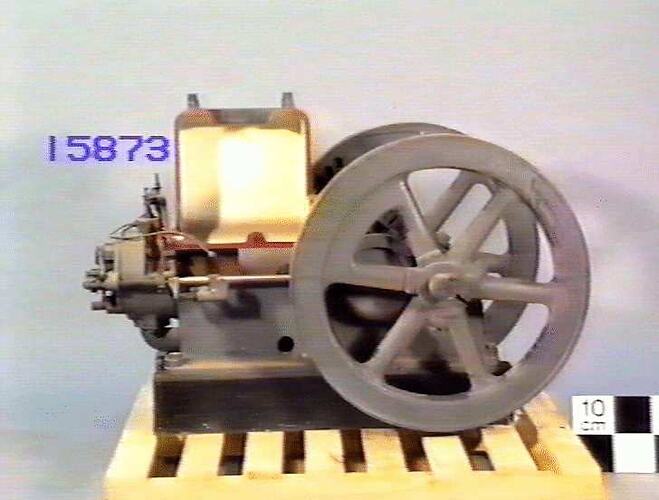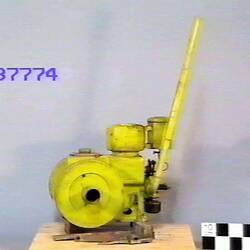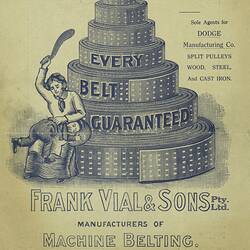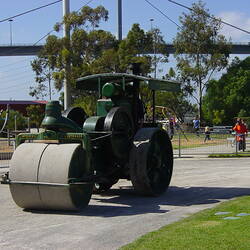Summary
Sectioned horizontal single-cylinder hooper-cooled semi-diesel compression-ignition stationary internal combustion engine, designed to operate on kerosene or light crude oil. Imperial "Super Diesel" F-Type model, Serial No.3011, rated for 5 horsepower (3.72 kW) at 500 r.p.m. Manufactured by A.H. McDonald & Co. Pty Ltd, of 570-574 Bridge Road, Richmond, Victoria in about 1922.
The history of the engine prior to being acquired by the Industrial & Technological Museum in 1925 is unknown, however, it was acquired from Frank Vial & Sons who operated a leather-belt manufacturing works in Melbourne. The engine was possibly used for driving machinery either at Vial's tannery and leather belt works or in another Melbourne factory prior to the introduction of electric motors.
Physical Description
Specifications: Bore x Stroke: 5-inch x 7-inch (127 mm x 178 mm) Power Rating: 5 brake horsepower (3.72 kW) at 500 r.p.m. Crankshaft: 2 3/8-inch diameter Flywheels: Two of 30-inch diameter x 2 5/8-inch face x 3 1/4-inch deep rim Belt Pulley: 8-inch diameter x 5-inch wide
Significance
As a general class of objects McDonald 'Super Diesel' engines played an important role in introducing mechanisation to a wide range of construction and rural industries throughout Australia with their low running costs and ability to operate on a variety of low grade fuels being particularly important to their success. They also played a key part in establishing the Australian manufacture of reliable diesel engine designs. Built in eight different sizes ranging from 2 to 20 horsepower, the McDonald 'Super Diesel' engines were manufactured from 1918 to 1950, with almost 13,000 engines produced in total, making them one of the most successful types of stationary internal combustion engine ever made in Australia. All of McDonald's 'Super Diesel' engines used the Brons or Hvid fuel injection system with compression ignition. The Brons system was originally invented by the Dutch engineer Jan Brons (1865-1954), however, McDonalds obtained the design from the United States, where the Danish-born engineer Rasmus Martin Hvid (1881-1950) applied for a patent on a combustion system in 1912 that appears to have been largely based on the Brons design. Hvid subsequently licensed the use of his improved Brons injection to several American engine manufacturers including the St Mary's Machine Co. of St Mary's, Ohio (llater known as the St Mary's Oil Engine Co. of St Charles, Missouri), from whom McDonalds copied both the brandname and design of their first "Super Diesel" engines.
A.H. McDonald & Co. were a notable Australian business, being one of the country's leading specialist manufacturers of both internal combustion engines, tractors and construction equipment throughout much of the 20th century. The company were one of the first firms to begin the manufacture of diesel engines in Australia and were particularly innovative in both their introduction of new technologies from overseas and the development of improved local designs. They were the first firm to manufacture tractors, petrol powered road rollers and diesel road rollers in Australia. The history of the 'Super Diesel' engine range and its successful production over a twenty year period is indicative of McDonald's general approach to product development and innovation, in which they often began by copying an established and proven overseas design, but then over subsequent years modified the basic design extending the range and capacity of models offered and adapting it to new applications.
More Information
-
Collecting Areas
-
Acquisition Information
Purchase
-
Manufacturer
Imperial Engine Works, A.H. McDonald & Co Pty Ltd, Richmond, Greater Melbourne, Victoria, Australia, 1922
Date of manufacture based on serial no. '3011' stamped on big-end bearing. The original registration record gave date of manufacture as circa 1923. -
Inscriptions
Stamped on each half of connecting-rod big-end bearing: '3011'
-
Model Name or Number
-
Brand Names
-
Classification
Mechanical engineering, Internal combustion power, Oil engines
-
Category
-
Discipline
-
Type of item
-
Dimensions
1295 mm (Length), 857 mm (Width), 876 mm (Height)
Original dimensions: 51-in. L x 33.75-in. W x 34.5-in. H; holding down bolt spacing 14-in. L x 11-in. W centre-to-centre.
-
References
"Australian Industries", The Advertiser (Adelaide, SA : 1889 - 1931), 3 Mar 1920, p.8, [Link 1] "A.H. McDONALD AND CO.", Eltham and Whittlesea Shires Advertiser and Diamond Creek Valley Advocate (Vic. : 1917 - 1922), 19 Mar 1920, p.3, [Link 2] "Save Selling Costs, Puchase this Engine by Mail [Advertisement]", Eltham and Whittlesea Shires Advertiser and Diamond Creek Valley Advocate (Vic. : 1917 - 1922), 19 Mar 1920, p.1, [Link 3]
[Book] McDonald, Kenneth N. 1988. A.H. McDonald Industrial Pioneer., p.23-35, 93-104. Pages
[Book] McDonald, Kenneth N. 1990. Fifty Years of McDonald Imperial Tractors, 1908-1958. 48 p. ill.
-
Keywords
Diesel Engines, Internal Combustion Engines, Oil Engines, Sectioned Exhibits






